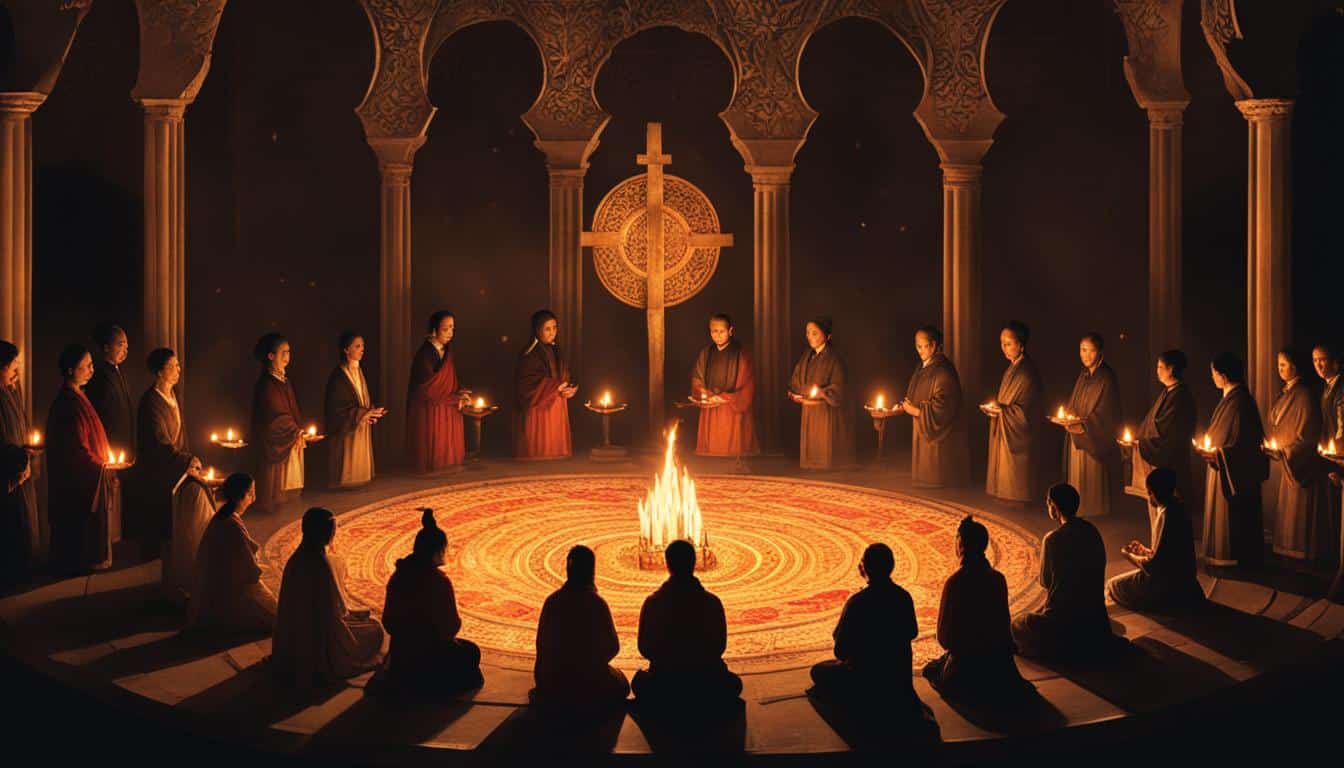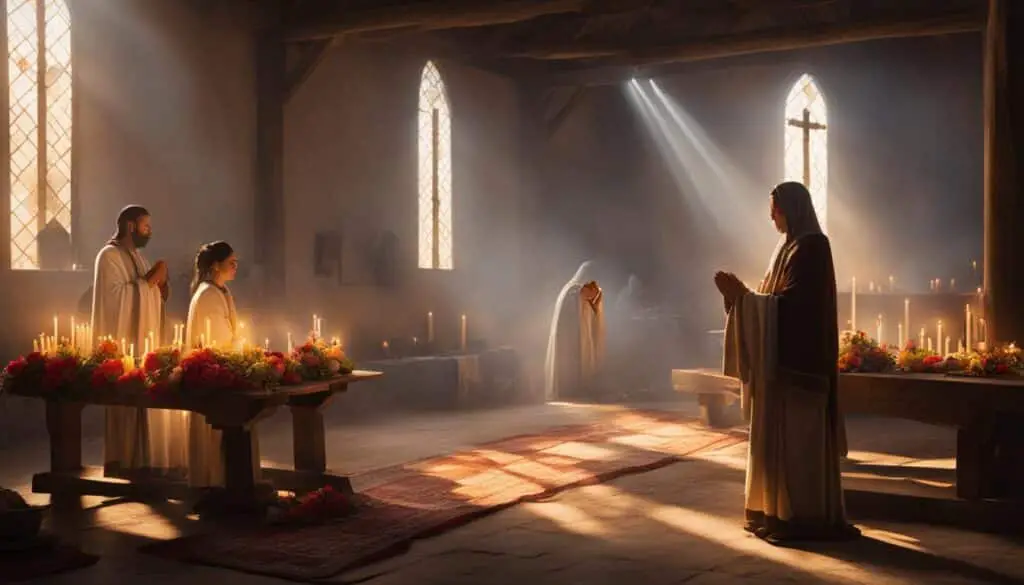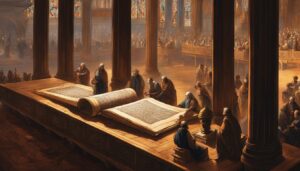
Early Christianity developed out of the eschatological ministry of Jesus and the beliefs of his earliest followers. The early Christians formed an apocalyptic messianic Jewish sect during the 1st century and believed in the resurrection of Jesus as the start of the end times. They also anticipated the Second Coming of Jesus and the establishment of God’s Kingdom at a later time.
The early Christian community had leaders such as James the Just, Peter, and John in Jerusalem, and the followers were first called Christians in Antioch. The early Christians spread the message of the Gospel throughout the classical world and founded apostolic sees. The early Christian practices included worship, rituals, ceremonies, traditions, spiritual practices, and community activities.
Key Takeaways:
- Early Christians believed in the resurrection of Jesus and the Second Coming.
- Early Christian practices included worship, rituals, ceremonies, traditions, spiritual practices, and community activities.
- Early Christian gatherings provided opportunities for worship, teaching, fellowship, and the sharing of meals.
- Early Christians engaged in acts of charity and service, caring for the poor, sick, and marginalized.
- Early Christian beliefs centered around the divinity of Jesus Christ and the importance of faith in him for salvation.
Early Christian Worship and Rituals
Early Christian worship was a central aspect of the early Christian communities. It served as a means for believers to gather together, express their devotion to God, and strengthen their faith. Worship was conducted through a variety of rituals and ceremonies that held significant importance for the early Christians.
One of the primary forms of worship was the gathering of believers in designated meeting places, private homes, or synagogues. These gatherings provided a space for communal praise, prayer, and the study of Scriptures. Hymns were sung, passages from the Old Testament and apostolic letters were read, and sermons and teachings were delivered to edify and instruct the community.
The centerpiece of early Christian worship was the participation in sacraments, particularly baptism and the Eucharist. Baptism, symbolizing the believer’s identification with the death and resurrection of Jesus, played a pivotal role in initiating individuals into the Christian community. The Eucharist, also known as the Lord’s Supper, held deep significance as it commemorated the body and blood of Jesus, reinforcing the spiritual bond among believers.
| Early Christian Worship and Rituals | Description |
|---|---|
| The Gathering of Believers | Early Christians met in private homes, synagogues, or designated meeting places to engage in communal worship, prayer, and study of Scriptures. Hymns were sung, and teachings were shared. |
| Baptism | Baptism symbolized the believer’s identification with Jesus’ death and resurrection and was an essential rite of initiation into the Christian community. |
| The Eucharist | The Eucharist, also known as the Lord’s Supper, was a sacred ceremony that commemorated the body and blood of Jesus, symbolizing the spiritual bond among believers. |
These worship practices and rituals created a sense of unity, reverence, and devotion among early Christians. They fostered a deep connection to God and served to strengthen the bonds of the Christian community. Through worship and participation in these rituals, early Christians found solace, guidance, and a shared experience of faith.

Growth and Evolution of Early Christian Worship
Early Christian worship and rituals evolved over time as the faith spread and developed within diverse cultural contexts. The primitive and intimate gatherings in private homes gradually expanded into more formalized and structured worship settings. As Christianity gained legal recognition and support under Emperor Constantine, grand basilicas and cathedrals were built to accommodate larger congregations.
The liturgical practices and order of worship also underwent transformation, with the emergence of liturgical calendars, liturgical music, and the establishment of an ordained clergy. These developments brought a greater sense of order and ceremonial beauty to early Christian worship, while also accommodating the needs of a growing and diverse congregation.
Despite these changes, the fundamental elements of early Christian worship remained consistent, focusing on communal spiritual growth, the remembrance of Jesus’ sacrifice, and the expression of devotion to God. The early Christian worship practices and rituals formed the foundation for the rich liturgical traditions that continue to shape contemporary Christian worship.
Early Christian Beliefs and Community Activities
Early Christians held a set of fundamental beliefs that formed the cornerstone of their faith. They firmly believed in the divinity of Jesus Christ and saw his death and resurrection as the ultimate act of salvation for humanity. It was through faith in Jesus that they believed eternal life could be attained. Additionally, early Christians placed great importance on the authority of the apostles and their teachings, trusting in their guidance and wisdom.
In terms of community activities, early Christians were known for their acts of charity and service. They had a strong commitment to caring for the poor, the sick, and the marginalized members of society. Their dedication to helping others mirrored the teachings of Jesus and exemplified their understanding of the importance of love and compassion.
Early Christians also placed a great emphasis on the study of Scripture and fellowship with one another. They believed that through the study of God’s word and regular gatherings, they could deepen their faith and strengthen their connection as a community. Early Christian gatherings were not only occasions for worship and teaching but also provided opportunities for mutual support and encouragement.
These community activities were central to the growth and spread of Christianity. The early Christians recognized that by living out their beliefs and actively engaging with their community, they could effectively share the message of the Gospel and attract others to their faith. Through their actions, they sought to exemplify the transformative power of Jesus’ teachings and draw others into a relationship with Him.
FAQ
What were the religious practices in early Christian communities?
Early Christian communities engaged in worship, rituals, ceremonies, traditions, spiritual practices, and community activities.
How did early Christians worship?
Early Christians gathered together to praise God, study Scriptures, pray, and share in sacraments such as baptism and the Eucharist.
What rituals and ceremonies were important in early Christianity?
The Lord’s Supper, symbolizing the body and blood of Jesus, and baptism, symbolizing identification with Jesus’ death and resurrection, were important rituals in early Christianity.
What were the beliefs of early Christians?
Early Christians believed in the divinity of Jesus Christ, his death and resurrection for the salvation of humanity, the authority of the apostles’ teachings, the existence of the Holy Spirit, and the eventual return of Jesus for final judgment.
What community activities did early Christians engage in?
Early Christians practiced acts of charity and service, caring for the poor, the sick, and the marginalized. They also committed themselves to the study of Scripture, fellowship with one another, and mutual support and encouragement of the faith.
How did early Christian gatherings contribute to the growth of Christianity?
Early Christian gatherings provided opportunities for worship, teaching, fellowship, and the sharing of meals. These activities strengthened the bonds of the early Christian communities and facilitated the growth and spread of Christianity.








